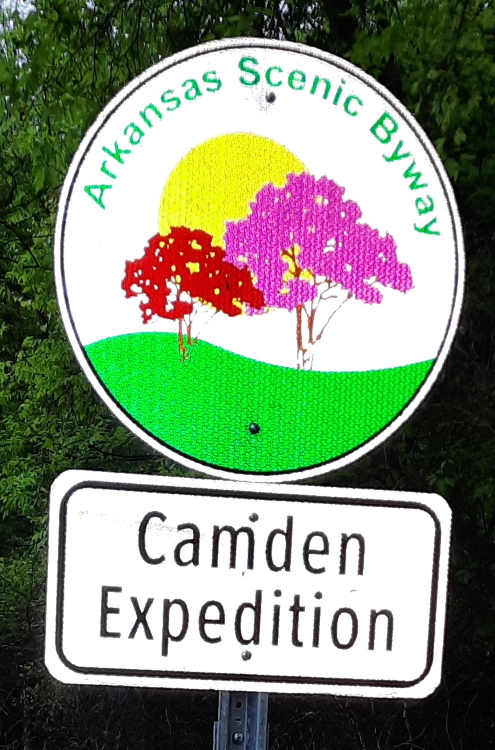Summary
April 28, 1864, Skirmish at Princeton
The Route
▷ We were last at Mt. Elba and had returned to the junction of US 79/US 167 and Arkansas 8 in Fordyce, which is our starting point.
▷ US 79/US 167 at Arkansas 8, Fordyce ARTurn right (northward) onto Arkansas 8 toward Princeton for 15.5 miles.
▷ Arkansas 8 at Arkansas 9, Dallas County ARTurn right (northward) onto Arkansas 8/Arkansas 9 for 1.9 more miles into Princeton, Arkansas.
▷ Arkansas 9 at Arkansas 8, Princeton ARContinue straight (northward) on Highway 9 north 8.1 miles to the north side of Tulip.
▷ Tulip Community Center next to the Tulip and Princeton Volunteer Fire Department.Proceed northward Arkansas 9 for 3.9 miles.
▷ Arkansas 9 at Arkansas 46, Dallas County ARTurn right (eastward) on Arkansas 46 and continue 5.7 miles (Highway 46 merges with 12th Avenue in Leola).
▷ Arkansas 46 at Grant 1/Old Camden Rd, Leola ARTurn right (southward) onto Cunningham St/Grant County Road 1/Old Camden Rd for 1.5 miles.
▷ Grant 1 becomes Dallas 409, Dallas County ARContinue 1/4 mile, bearing right, when Grant 1 becomes Dallas 409.
▷ Dallas 409 at Phillips Trail, Dallas County ARPhillips Trail branches off (to the right) about 1/2 mile before the approximate site of the skirmish at Guesses Creek. There's a marker at the site of the Cannonball House. Return the 1.9 miles to Arkansas 46/12th Avenue.
▷ Grant 1 at Arkansas 46, Leola ARPrepare to turn right (eastward) onto Arkansas 46.
▷ This brings us to the next point of interest, Saline Bottoms.
Google Maps
Show my location on map
At the popup, you must allow your web brower (not us) to know your location.
Your location should update every 5 seconds.
This brings us to the next point of interest, Saline Bottoms.
Princeton
With the news of the disaster at Marks' Mills on the 25th of April just a week after Poison Spring, with the pressure from Confederate General Sterling Price's army just west of Camden, with the knowledge that Confederate General Kirby Smith was moving into Arkansas from Shreveport and that Union General N. P. Banks had not been successful in Louisiana and was moving south along the Red River and with the on-going problem of feeding his hungry army, General Frederick Steele had to make a decision. He met with his officers, and the decision was to return to Little Rock via Jenkins' Ferry as soon as possible.
On April 26th Steele's forces prepared for the retreat cautiously so as not to alert the citizens of Camden. Wagons and equipment that could not be moved were destroyed. Soldiers got rations for the journey though they were scanty. What could be moved across the bridge over the river without exciting interest was moved during daylight. In the evening after taps and in full darkness, Steele's forces began crossing the bridge until all the units had withdrawn across the Ouachita by about 1 AM on April 27th. By dawn, the bridge had been dismantled, deflated and packed away for transport, and the last of the Federal force was on the eastern bank of the Ouachita and moving away from Camden.
The exhausted Union troops who had crossed earlier rested when they were out of artillery range of any Confederate forces in Camden until the last of their force arrived, and then they all resumed their march on the military road. Those bringing up the rear had no rest. They spent the night of the 27th at Freeo in northeastern Ouachita County, They were able to find some corn for their livestock and were up before dawn on April 28th to move on toward Princeton, leaving a trail of debris along their route of items that the weary soldiers could no longer manage to carry.
As the Union troops marched forward, the Confederates now under the command of General Kirby Smith learned from their patrols that Camden had been abandoned. Confederate forces entered the city at 9 AM on April 27th, but they had no pontoon bridge to cross the river and follow the retreating Union Army. They had to gather the materials and build a crude raft bridge before they could pursue Steele. It would be the morning of April 28th before they could begin crossing the Ouachita.
On April 26th Steele's forces prepared for the retreat cautiously so as not to alert the citizens of Camden. Wagons and equipment that could not be moved were destroyed. Soldiers got rations for the journey though they were scanty. What could be moved across the bridge over the river without exciting interest was moved during daylight. In the evening after taps and in full darkness, Steele's forces began crossing the bridge until all the units had withdrawn across the Ouachita by about 1 AM on April 27th. By dawn, the bridge had been dismantled, deflated and packed away for transport, and the last of the Federal force was on the eastern bank of the Ouachita and moving away from Camden.
The exhausted Union troops who had crossed earlier rested when they were out of artillery range of any Confederate forces in Camden until the last of their force arrived, and then they all resumed their march on the military road. Those bringing up the rear had no rest. They spent the night of the 27th at Freeo in northeastern Ouachita County, They were able to find some corn for their livestock and were up before dawn on April 28th to move on toward Princeton, leaving a trail of debris along their route of items that the weary soldiers could no longer manage to carry.
As the Union troops marched forward, the Confederates now under the command of General Kirby Smith learned from their patrols that Camden had been abandoned. Confederate forces entered the city at 9 AM on April 27th, but they had no pontoon bridge to cross the river and follow the retreating Union Army. They had to gather the materials and build a crude raft bridge before they could pursue Steele. It would be the morning of April 28th before they could begin crossing the Ouachita.
Princeton Marker
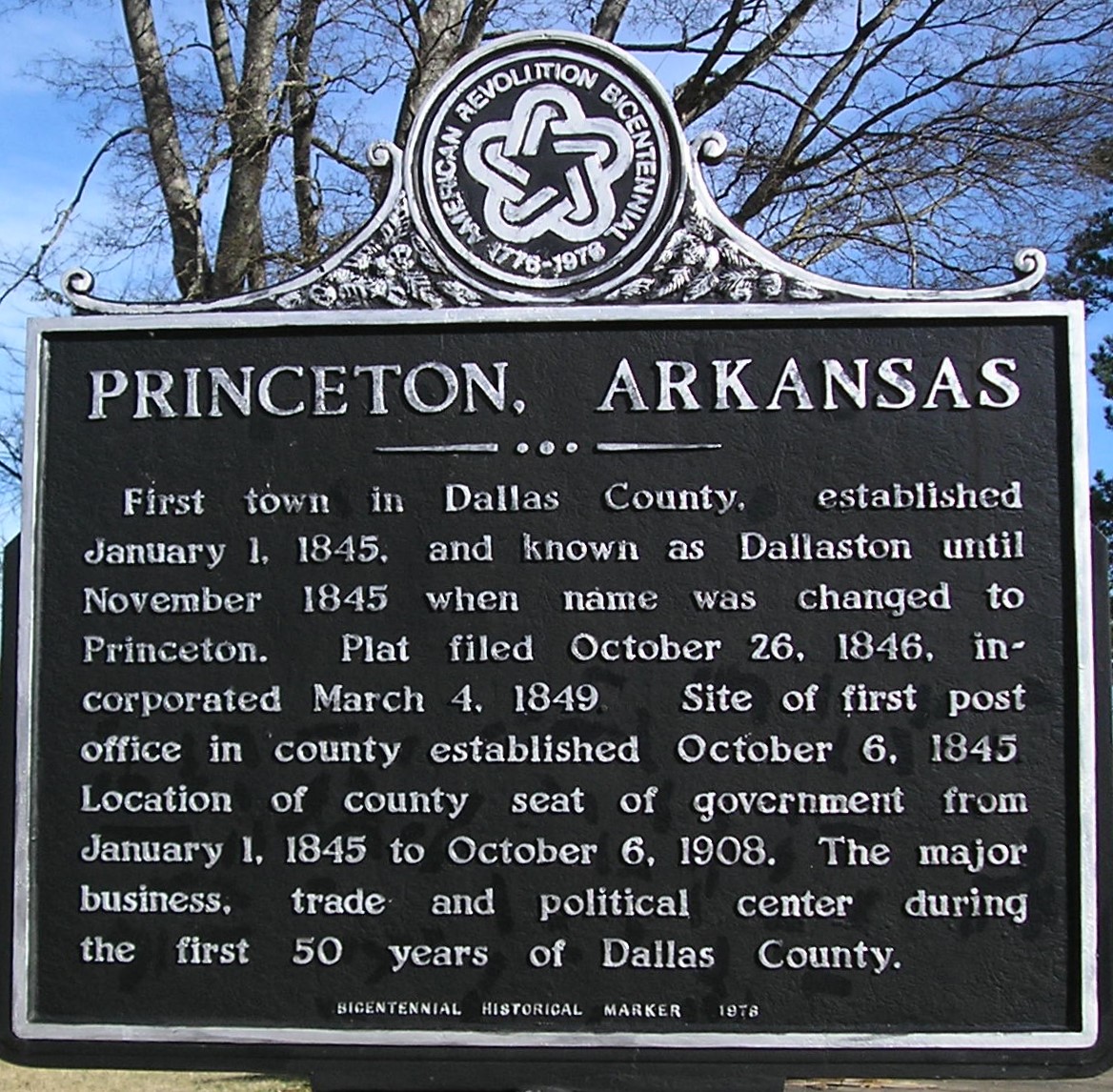
First town in Dallas County, established January 1, 1845, and known as Dallaston until November 1845 when name was changed to Princeton. Plat filed October 26, 1846, incorporated March 4, 1849. Site of the first post office in county established October 6, 1845. Location of county seat of government from January 1, 1845 to October 6, 1908. The major business, trade and political center during the first 50 years of Dallas County.
Bicentennial Historical Marker 1976
At the time of the Camden Expedition, Princeton had been the county seat of Dallas County from the county's formation on January 1, 1845, but it had first been known as Dallastown until November of 1845 when it was re-named "Princeton". This town remained the seat of county government, politics and business for over fifty years. After the Civil War, its importance was superseded by the railroad town of Fordyce in the 1880s. Fordyce became the center for transportation, for the growing timber industry and for business. It became the county seat in 1908. Princeton had also derived some of its early importance from having the first post office in the immediate region in 1843, some two years before the county was formed from Clark County. A 1976 American Bicentennial marker in the center of town details this early history of what is now a quiet village.
The Union Army arrived in Princeton about 1 PM on the afternoon of April 28th and camped in the fields around the town. They were able to forage and found meat for the men but nothing for the livestock. Cavalry under General E. A. Carr was leading the Union forces and encountered Confederates of the 1st Missouri north of Princeton. Major Benjamin Elliott of the 1st Missouri had been sent out by General Joe Shelby to determine if Steele's force had left Camden and then report back to General J. S. Fagan at Pratt's Ferry. Elliott used his companies to slow down Carr and had some success. Thinking he had gotten the information he needed and had accomplished his mission, Elliott pulled back to report to Fagan but could not locate him at Pratt's Ferry. Fagan, in need of forage, had moved toward Arkadelphia. Under orders to be up at 4 AM on April 29th, the Union forces were again on the move early the next morning marching north toward Tulip.
Photo by Peggy Lloyd
Arkansas Military Institute Marker
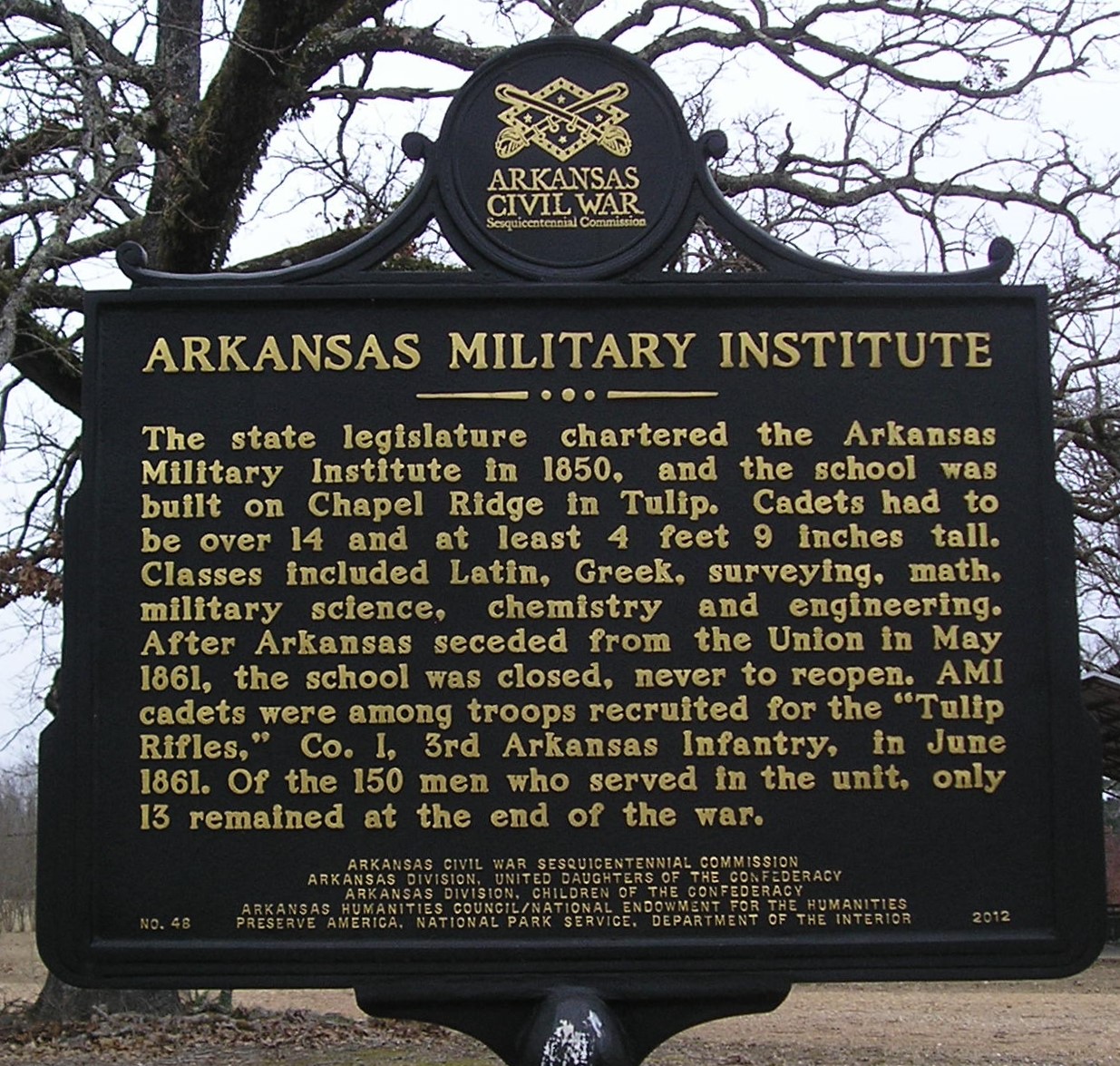
A Civil War Sesquicentennial marker stands near the Tulip Community Center, a former schoolhouse, and gives information on Tulip's importance as a center for education:
The state legislature chartered the Arkansas Military Institute in 1850, and the school was built on Chapel Ridge in Tulip. Cadets had to be over 14 and at least 4 feet 9 inches tall. Classes included Latin, Greek, surveying, math, military science, chemistry and engineering. After Arkansas seceded from the Union in May 1861, the school was closed, never to reopen. AMI cadets were among troops recruited for the Tulip Rifles, Co. I, 3rd Arkansas Infantry, in June 1861. Of the 150 men who served in the unit, only 13 remained at the end of the war.
The community of Tulip once consisted of well-to-do planters and slaveholders who were interested in providing a good education for their children and established the military academy and a seminary for girls. These schools became the basis for Tulip's reputation as "The Athens of Arkansas". A group of some twenty families who had migrated to Arkansas from Tennessee and North Carolina to raise cotton and who had established comfortable homes for their families and good schools for their children gave Tulip its glory years in the period from 1842 to 1862. The military academy for boys attracted students from outside the immediate community until it was disbanded at the beginning of the Civil War.
Photo by Peggy Lloyd
Tulip in the Civil War Marker
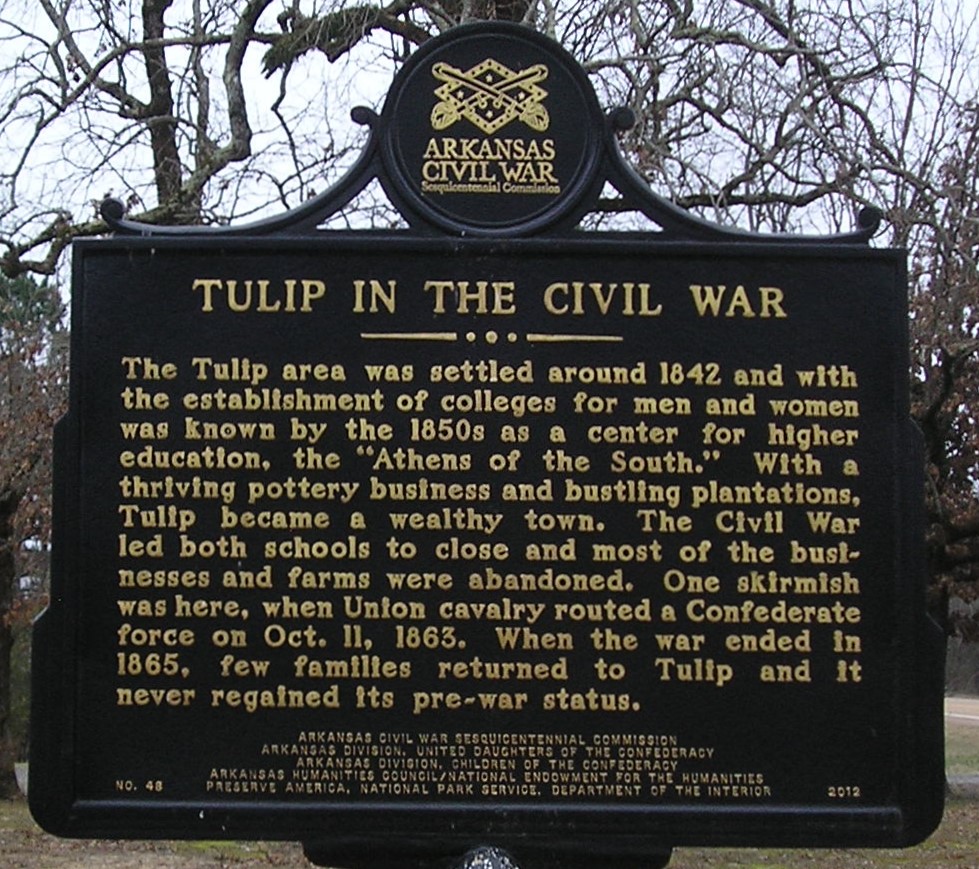
The Tulip area was settled around 1842 and with the establishment of colleges for men and women was known by the 1850s as a center for higher education, the Athens of the South. With a thriving pottery business and bustling plantations, Tulip became a wealthy town. The Civil War led both schools to close and most of the businesses and farms were abandoned. One skirmish was here, when Union cavalry routed a Confederate force on Oct. 11, 1863. When the war ended in 1865, few families returned to Tulip and it never regained its pre-war status.
The skirmish mentioned on the marker was led by Union Col. Powell Clayton who would become governor of Arkansas during Reconstruction and a dominant figure in Arkansas Republican politics until his death in 1914. At the request of citizens from Pine Bluff, General Frederick Steele had ordered Col. Powell Clayton to establish a garrison in their city. Clayton had done this by Sept. 19, 1863.
Aware that Confederate forces were monitoring his activities, Clayton decided to act. Less than a month later on Oct. 11, Clayton with a force of 300 troops attacked Col. Archibald Dobbins' First Arkansas Cavalry at their encampment near Tulip at 4 AM and completely routed the force of 600. The Union troops took some prisoners and most of their abandoned equipment and gear. Those that escaped capture fled to Arkadelphia. This sudden and successful raid rattled the Confederate forces.
The community would see both Confederate and Union forces passing by, camping and fighting in the vicinity in 1863 and 1864 with the Camden Expedition. With the end of the war and slavery and changes in the economy during Reconstruction, Tulip continued to decline as older residents died and younger people moved away in search of other opportunities. A community center, churches and a scattering of homes are what remains today.
Photo by Peggy Lloyd
Tulip Methodist Church
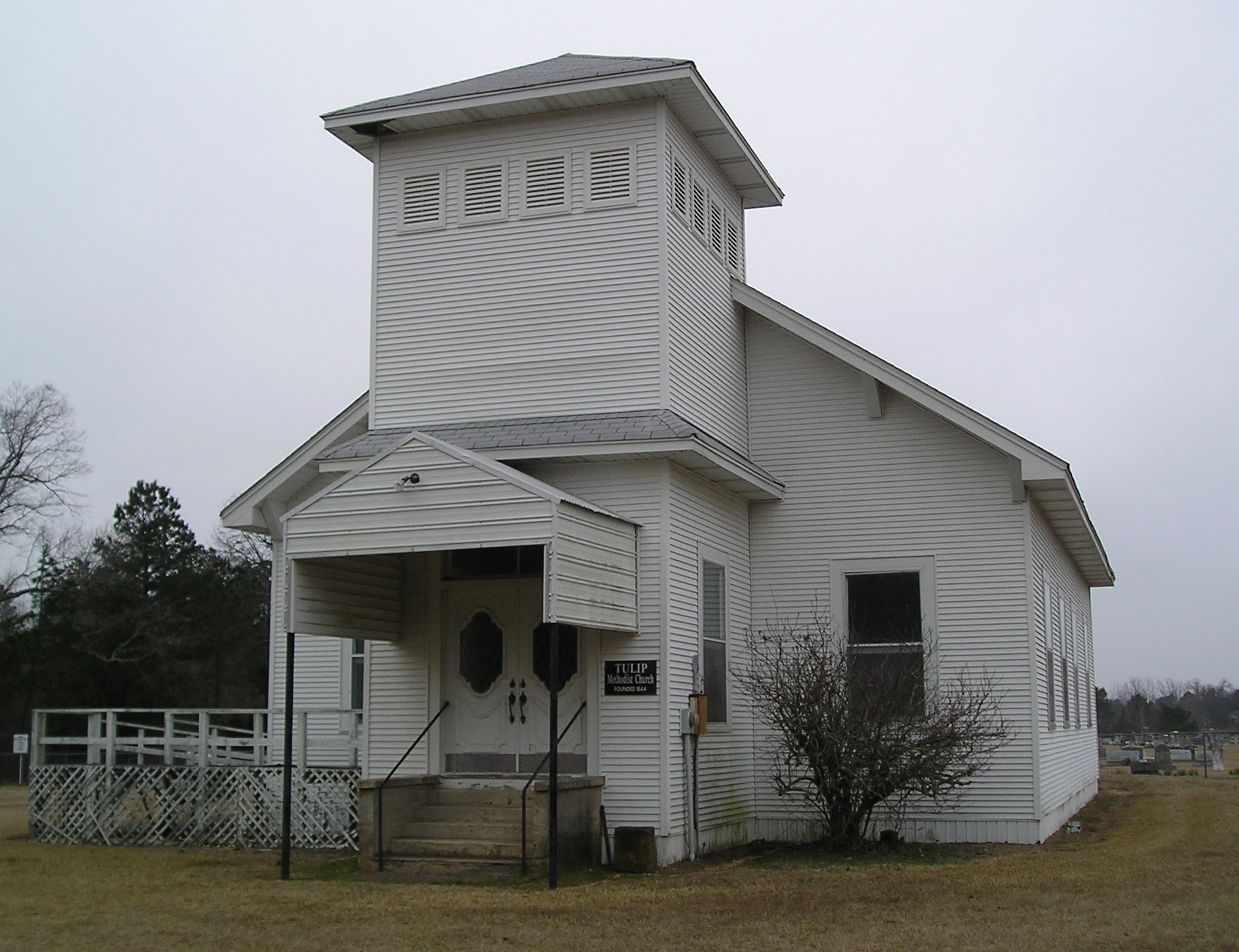
Another point of interest at Tulip is the Tulip Methodist Church and cemetery. Go south on Highway 9 a short distance from the Community Center and the Tulip-Princeton Volunteer Fire Dept. and take Dallas County Road 301 to the church which is visible from Highway 9. Located behind the Methodist Church is the Tulip Cemetery. The burial ground for many early settlers in the area with its oldest grave dating from the early 1840s, it also has associations with Civil War in the region and the Camden Expedition.
Two Confederate officers from Walker's Texas Brigade who were wounded in the fighting at Jenkins' Ferry were temporarily interred at the Tulip Cemetery. They were Brigadier General William Read Scurry (1821-1864) and Colonel Horace Randal (1833-1864). Scurry commanded the Third Brigade of Walker's Texas Division and was well known in Texas where he had had a career as a lawyer, public official, army officer and newspaper owner and editor. He was wounded at Jenkins' Ferry on April 30, 1864, and died the same day. He was buried at Tulip on May 2 with full military honors. Col. Randal, a West Point graduate, was also a brigade commander though he was not yet a brigadier general. Kirby Smith had promoted him to brigadier general on his own authority, a promotion that Jefferson Davis rejected. Randal was wounded at Jenkins' Ferry on April 30 and died two days later an hour after Scurry's funeral. He too was buried at Tulip with full military honors the next day.
The bodies of both Scurry and Randal were later removed to Texas. Scurry was buried in the State Cemetery at Austin. After the war, the State of Texas placed a thirteen-foot high marble shaft on his grave. Randal was moved to Marshall, Texas, and buried in the Marshall Cemetery. In 1876, when several new counties were being formed in northwest Texas, two were named "Scurry" and "Randall" to honor these two officers. Randall County was misspelled with two l's through clerical error.
Photo by Peggy Lloyd
Tulip Cemetery
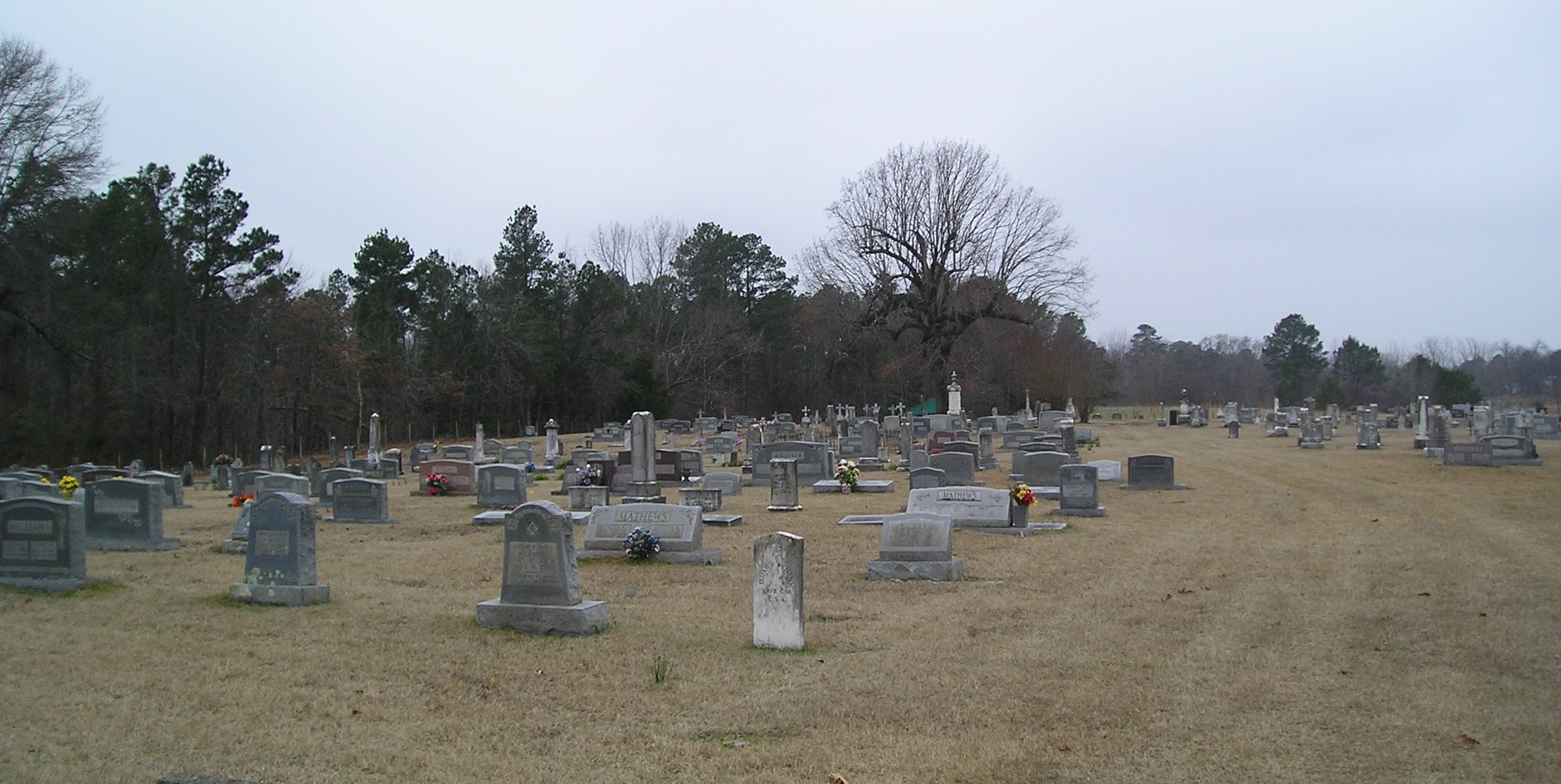
Photo by Peggy Lloyd
Edward W. Gantt Gravestone
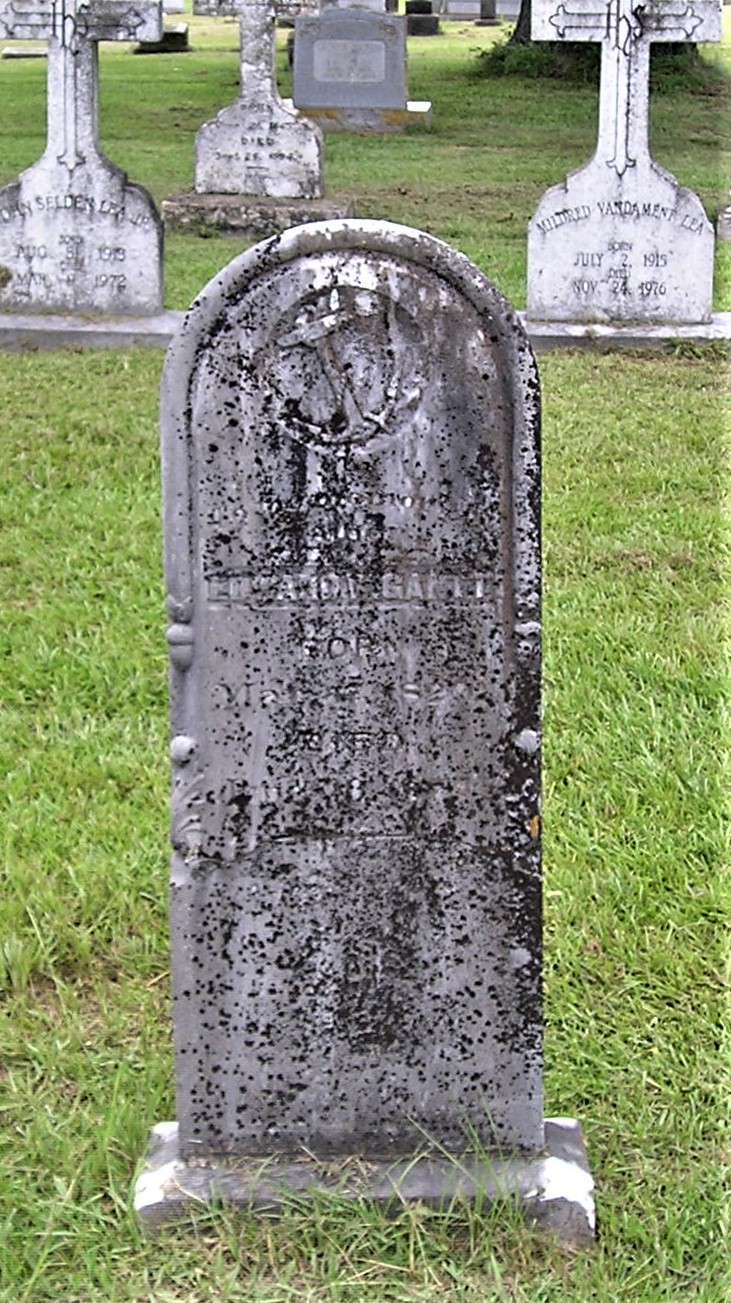
Another historic figure of national consequence, though little known now, was buried at Tulip just over a decade after the Camden Expedition. Edward W. Gantt (1829-1874) came to Arkansas from Tennessee in the early 1850s and was initially in Camden before becoming the prosecuting attorney in Washington, Arkansas. He married Margaret Reid, daughter of a prominent Tulip planter, in 1855. He successfully ran for Congress in 1860 but never took his seat because of secession.
Gantt championed secession and became the colonel of the 12th Arkansas Infantry. His military career was not successful. Gantt was taken prisoner by Union forces at Island No. 10 near New Madrid and went to a Union prison camp. Exchanged a few months later, he returned to Richmond, Virginia, and sought another command unsuccessfully. He returned to Arkansas and put his affairs in order.
In early June 1863, Gantt turned himself over to U. S. Grant at Vicksburg and offered his help. Grant sent him to Abraham Lincoln in Washington. Gantt was what Lincoln had hoped for: a prominent southerner who had seen the error of his ways and wanted to end the war and rejoin the Union. Gantt returned to Arkansas after the Union Army re-took Little Rock and made a widely publicized speech urging Arkansans to end the fighting, rejoin the Union and accept the end of slavery. In 1863 and 1864 he spoke widely in the North and received extensive coverage in the press. After the end of the war and the death of Lincoln, Gantt was appointed head of the Freedmen's Bureau regional office in Washington, Arkansas, and aided the newly emancipated slaves. Returning to Little Rock in 1866, he became the prosecuting attorney and was heavily involved in Republican politics. Despised by many Arkansans, Gantt received negative press and threats of violence and took a beating that was reported in the Arkansas Gazette.
Stressed and drinking heavily, Gantt resigned as prosecuting attorney and started work on a Digest of Arkansas laws. Gantt died suddenly on June 10, 1874, of a heart attack and was buried at Tulip, the site of his wife's home. His daughter Cora Gantt Banks (1859-1884), who died in childbirth, was later buried beside him. Maurice Smith (1801-1871), one of the most prominent members of the Tulip community and who had also married into the Reid family, is buried nearby. These graves are located about halfway or slightly more toward the back of the cemetery and to the left of the walkway or drive that divides the cemetery. Gantt's gravestone has the motif of an anchor on it.
Photo by Peggy Lloyd
Skirmish at Guesses Creek Marker
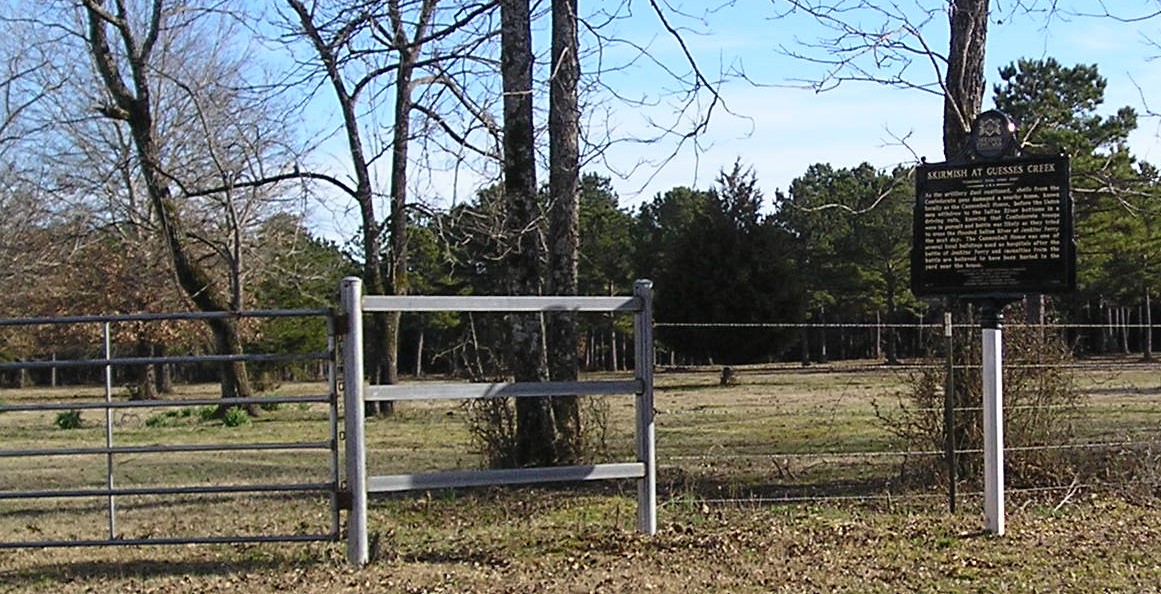
This marker along a country road outside Leola marks the spot where the Confederate forces coming out of Camden in pursuit of General Steele's troops finally caught up with the Union Army. Delayed a day by not having a pontoon bridge and having to construct a raft bridge, the Confederate forces left their supply wagons in Camden to speed up their progress and simply carried what supplies they could in order to catch the retreating Union Army. They caught the Union troops near Guesses Creek. Today the Civil War Sesquicentennial marker stands beside the county road on a pleasant hill near an old homesite that is marked only by jonquils that still bloom in the spring. The marker describes the events of April 29, 1864:
General Frederick Steele's Union Army left Camden on April 26, 1864, starting a retreat to Little Rock. Confederate pursuers caught up with them on April 29 on the Jenkins' Ferry Road and began skirmishing. Union gunners of the 2nd Missouri Artillery held them back as Confederate Col. W. L. Jeffers deployed his troops. Harris's Confederate Battery was sent to his support as soldiers of Burbridge's Missouri Regiment came up. Union troops of the 40th Iowa, 43rd Illinois and 27th Wisconsin supported the Missouri battery as it held off the Confederates. As the artillery duel continued, shells from the Confederate guns damaged a nearby home, known locally as the Cannonball House, before the Union men withdrew to the Saline River Bottoms in a driving rain, knowing that Confederate troops were in pursuit and battle was likely as they tried to cross the flooded Saline River at Jenkins' Ferry the next day. The Cannonball House was one of several local buildings used as hospitals after the Battle of Jenkins' Ferry and casualties from the battle are believed to have been buried in the yard near the house.
The heavy rains would continue into the next day making conditions more and more difficult for the movement of both armies, for their animals and for the gear or equipment they either hauled or attempted to carry on their persons. The vanguard of the Union Army had already reached Jenkins' Ferry as the troops in the rear engaged in an artillery duel with the pursuing southerners.
Photo by Peggy Lloyd
Up Next
This brings us to the next point of interest, Saline Bottoms.
